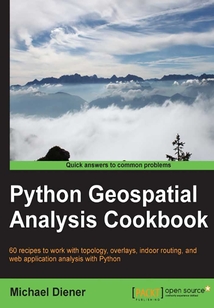舉報 

會員
Python Geospatial Analysis Cookbook
最新章節:
Index
Ifyouareastudent,teacher,programmer,geospatialorITadministrator,GISanalyst,researcher,orscientistlookingtodospatialanalysis,thenthisbookisforyou.AnyonetryingtoanswersimpletocomplexspatialanalysisquestionswillgetaworkingdemonstrationofthepowerofPythonwithreal-worlddata.SomeofyoumaybebeginnerswithGIS,butmostofyouwillprobablyhaveabasicunderstandingofgeospatialanalysisandprogramming.
目錄(100章)
倒序
- 封面
- 版權頁
- Credits
- About the Author
- About the Reviewers
- www.PacktPub.com
- Support files eBooks discount offers and more
- Preface
- What this book covers
- What you need for this book
- Who this book is for
- Sections
- Conventions
- Reader feedback
- Customer support
- Chapter 1. Setting Up Your Geospatial Python Environment
- Introduction
- Installing virtualenv and virtualenvwrapper
- Installing pyproj and NumPy
- Installing shapely matplotlib and descartes
- Installing pyshp geojson and pandas
- Installing SciPy PySAL and IPython
- Installing GDAL and OGR
- Installing GeoDjango and PostgreSQL with PostGIS
- Chapter 2. Working with Projections
- Introduction
- Discovering projection(s) of a Shapefile or GeoJSON dataset
- Listing projection(s) from a WMS server
- Creating a projection definition for a Shapefile if it does not exist
- Batch setting the projection definition of a folder full of Shapefiles
- Reprojecting a Shapefile from one projection to another
- Chapter 3. Moving Spatial Data from One Format to Another
- Introduction
- Converting a Shapefile to a PostGIS table using ogr2ogr
- Batch importing a folder of Shapefiles into PostGIS using ogr2ogr
- Batch exporting a list of tables from PostGIS to Shapefiles
- Converting an OpenStreetMap (OSM) XML to a Shapefile
- Converting a Shapefile (vector) to a GeoTiff (raster)
- Converting a raster (GeoTiff) to a vector (Shapefile) using GDAL
- Creating a Shapefile from point data stored in Microsoft Excel
- Converting an ESRI ASCII DEM to an image height map
- Chapter 4. Working with PostGIS
- Introduction
- Executing a PostGIS ST_Buffer analysis query and exporting it to GeoJSON
- Finding out whether a point is inside a polygon
- Splitting LineStrings at intersections using ST_Node
- Checking the validity of LineStrings
- Executing a spatial join and assigning point attributes to a polygon
- Conducting a complex spatial analysis query using ST_Distance()
- Chapter 5. Vector Analysis
- Introduction
- Clipping LineStrings to an area of interest
- Splitting polygons with lines
- Finding the location of a point on a line using linear referencing
- Snapping a point to the nearest line
- Calculating 3D ground distance and total elevation gain
- Chapter 6. Overlay Analysis
- Introduction
- Punching holes in polygons with a symmetric difference operation
- Union polygons without merging
- Union polygons with merging (dissolving)
- Performing an identity function (difference + intersection)
- Chapter 7. Raster Analysis
- Introduction
- Loading a DEM USGS ACSII CDED into PostGIS
- Creating an elevation profile
- Creating a hillshade raster from your DEM with ogr
- Generating slope and aspect images from your DEM
- Merging rasters to generate a color relief map
- Chapter 8. Network Routing Analysis
- Introduction
- Finding the Dijkstra shortest path with pgRouting
- Finding the Dijkstra shortest path with NetworkX in pure Python
- Generating evacuation polygons based on an indoor shortest path
- Creating centerlines from polygons
- Building an indoor routing system in 3D
- Calculating indoor route walk time
- Chapter 9. Topology Checking and Data Validation
- Introduction
- Creating a rule – only one point inside a polygon
- A point must be on the starting and ending nodes of a line only
- LineStrings must not overlap
- A LineString must not have dangles
- A polygon centroid must be within a specific distance of a line
- Chapter 10. Visualizing Your Analysis
- Introduction
- Generating a leaflet web map with Folium
- Setting up TileStache to serve tiles
- Visualizing DEM data with Three.js
- Draping an orthophoto over a DEM
- Chapter 11. Web Analysis with GeoDjango
- Introduction
- Setting up a GeoDjango web application
- Creating an indoor web routing service
- Visualizing an indoor routing service
- Creating an indoor route-type service
- Creating an indoor route from room to room
- Appendix A. Other Geospatial Python Libraries
- Appendix B. Mapping Icon Libraries
- Index 更新時間:2021-07-30 10:13:41
推薦閱讀
- Visual C++串口通信開發入門與編程實踐
- ASP.NET Core 5.0開發入門與實戰
- Julia機器學習核心編程:人人可用的高性能科學計算
- 微信小程序入門指南
- Building Android UIs with Custom Views
- Create React App 2 Quick Start Guide
- C# Multithreaded and Parallel Programming
- Cocos2d-x by Example:Beginner's Guide(Second Edition)
- HTML5+CSS3+JavaScript 從入門到項目實踐(超值版)
- Arduino電子設計實戰指南:零基礎篇
- Java并發實現原理:JDK源碼剖析
- 從“1”開始3D編程
- C++17 By Example
- 前端程序員面試算法寶典
- Hands-On Artificial Intelligence with Unreal Engine
- Python大數據與機器學習實戰
- Mastering Python for Data Science
- 深入淺出Rust
- Getting Started with SQL Server 2014 Administration
- Xamarin Mobile Application Development for Android(Second Edition)
- INSTANT Jsoup How-to
- 軟件工程基礎
- OAuth 2實戰寶典
- Mastering the Nmap Scripting Engine
- Go語言項目開發上手指南
- Java程序員面試筆試通關寶典
- 大學信息基礎
- Learning BeagleBone Python Programming
- 數據庫程序員面試筆試通關寶典
- Apache Spark 2:Data Processing and Real-Time Analytics

